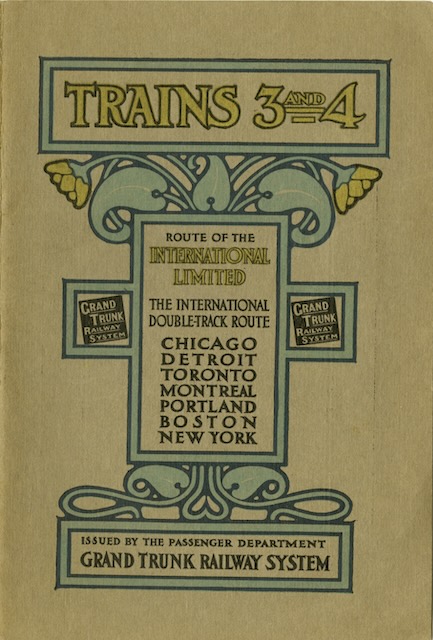I noted a few months ago that one of the signs of the Golden Age of passenger trains was the use of evocative names for a railroad’s premiere trains. What could be less evocative than “trains 3 & 4”? Yet that is the “name” of the trains that are the subject of this 1913 booklet of the same title.
 Click image to download an 11.3-MB PDF of this 36-page booklet.
Click image to download an 11.3-MB PDF of this 36-page booklet.
Trains 3 & 4 were in many ways the premiere trains of the Grand Trunk Railway, connecting Chicago with both Montreal and New York City. The booklet’s subtitle was “Route of the International Limited,” which referred to trains 1 & 2 between Montreal and Chicago and Grand Trunk’s only named trains at the time. But trains 3 & 4 had cars going to New York City, which would have been more important to Chicagoans than Montreal.
Page 5 of the booklet describes train 4 as a “solid train” that left Chicago behind “one of the new standard ten-wheeled passenger engines,” meaning a 4-6-0. Such a “standard” engine was actually several years behind the times as it had been superseded on most major U.S. railroads by more powerful 4-6-2 locomotives. Grand Trunk’s 4-6-0s had been superheated by 1913 and produced around 33,000 pounds of tractive effort. Grand Trunk had acquired a few 4-6-2 locomotives in 1912 that produced closer to 35,000 pounds of tractive effort, but according to Wikipedia used them mainly for freight.
The booklet says train 4 consisted of sleeping cars and first-class coaches destined for Buffalo, New York City, and Toronto, sleeping cars to Montreal and Boston, and a dining car. The train would add other sleepers between Detroit and Buffalo, Buffalo and Philadelphia, and Detroit and Toronto, a coach from Toronto to Montreal, and coaches and sleepers between Montreal and Portland. Including a baggage car, that’s more than a dozen cars along parts of the route, which seems beyond the capability of a 4-6-0. I suspect that the Buffalo cars actually went all the way to New York, the Toronto cars went to Montreal, and one of the Montreal cars went all the way to Boston, thus reducing the count to at most eight cars between Detroit and Hamilton and no more than six for the rest of the route.
This booklet uses the phrase “solid train” four times. I originally thought this phrase meant that the train traveled as a single unit, with no additions or subtractions of cars along the way, but that obviously isn’t the case with trains 3 & 4. So I’m not sure what was meant by a solid train, a term that didn’t carry over into the modern era.
Grand Trunk didn’t actually go to either Boston or New York City. Train 4 went from Chicago through Detroit to Hamilton, Ontario, where it was split into Montreal and Buffalo sections. The Montreal train terminated there but one car went to Boston via Central Vermont (which was owned by Grand Trunk) and Boston & Maine (which wasn’t). The schedule shows another car going between Montreal and Portland on tracks owned by Grand Trunk, but that was a different train and there was no through car from Chicago to Portland.
The Buffalo section crossed the Niagara River on a spectacular arch bridge shown on page 12 of this booklet and handed over the New York and Philadelphia cars at Buffalo to the Lehigh Valley Railroad. Grand Trunk timetables indicate passengers could also take the New York Central, but they would have to change cars and would arrive in New York City no sooner than over the Lehigh Valley, so they would only do so if going to an intermediate destination, such as Albany, that wasn’t on the Lehigh route.

Ottawa as portrayed by Richard Rummell. Click image for a larger view.
This booklet contains numerous black-and-white photographs of various quality, but page 24 shows a full-page illustration of Ottawa featuring the parliament building, Grand Trunk’s train station, and Grand Trunk’s new Chateau Laurier, which had opened in June 1912. This illustration is actually from a 1911 painting by Richard Rummell (1848-1924).
Though born in Canada, Rummell’s family moved to the U.S. when he was young. He was apparently a self-taught artist, and by the time he was in his thirties, he had set up a studio in New York City where he specialized in bird’s-eye-view paintings of cities and college campuses. There were many illustrators who did such bird’s-eye-views, and while some speculate that Rummell used a hot-air balloon to make his drawings, there is no physical evidence of that and it seems likely that he and his competitors did their work from the ground using standard rules of perspective.
Rummell’s Ottawa painting was almost certainly commissioned by Grand Trunk, which reprinted it in what one web site calls “the most spectacular chromolithograph ever produced in Canada, and the largest” at 28″x42″. Though the Chateau Laurier was on the right side, it managed to dominate the painting, rendering the parliament buildings somewhat inconsequential. This must have pleased Grand Trunk officials who were, in fact, heavily dependent on subsidies from the Canadian government.
